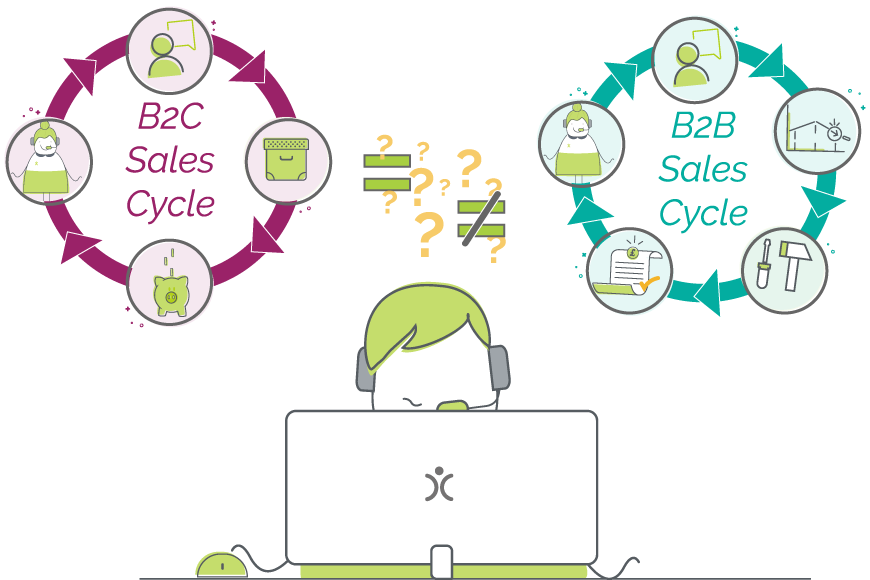Separating B2C from B2B Sales – 3 Techniques for Success
13 Aug 2018
Sales is sales, right? Well actually, I don’t think so. I think there’s a big difference between what is known as B2B and B2C–both in selling and buying.
It’s been proven that the way we all buy in our personal lives is far different from the way businesses come to their next buying decision. After all, when you go and buy that piece of cake, you don’t have to consider what the ROI might be.
Business-to-business (or B2B) sales has always been considered more difficult when compared to selling direct to consumers (B2C – Business to Consumer). But, with sales quotas waiting to be filled and businesses depending on the turnover, B2B sales have to be maximised.
To help boost everyone’s commissions this month, let’s take a look at how B2B sales differ from B2C. I’d also like to explore some classic sales techniques you can implement to increase your chances of success.
The ‘I Want’ vs The ‘I Need’
Let’s start with a question:
How many of the things in your home did you buy because you wanted them?
Then ask yourself a second question:
Out of those things, how many of them did you need?
You’ll go home this evening, sit on the sofa with a glass of wine or some chocolate and watch the TV. How many of those things do you actually need? Do you need a TV? Do you need chocolate or wine? But what do all these things have in common? You wanted them!
When we purchase as a consumer, the want often trumps the need. A 2013 article from Psychology Today proves this theory. The researchers found that when evaluating brands, consumers primarily use emotions (personal feelings and experiences) to inform their decision.
So, with B2C sales, it’s all about either creating or supplying the want that a customer has. You need to make them desire your product.
How’s B2B different?
Let’s follow the same tack. Look around your office, or just your desk, and ask yourself – how many of these things did my business need?
For example, you may be sat at a desk, with a computer or laptop on it, and a phone by your side. Well, the business needs desks for staff to work from, a computer to carry out daily tasks and a phone to communicate with other staff and customers.
Sure, “want” comes into the decision at some stage, but the overriding requirement here is a business need – a product or service to enable outputs to be created.
For B2B sales, you need to show how you can adequately meet the need of the customer. This is typically done through the attributes of your brand or the features and facts of your product or service.
In Short – Consumers buy emotionally, getting what they want. Businesses buy conservatively, purchasing only what they need.
Buyer Accountability
When making a buying decision, we all have a process we go through to determine if a certain product is the right one for us. As a consumer or a business, the process will look different. One of the main reasons for this is accountability.
Let me explain…
When a consumer buys a product, typically for themselves, the mechanics of that purchase are all on their shoulders. When buying they may factor in variables such as the need (or lack of it), costs, alternatives, risks and consequences. But what makes this decision quicker (and often easier for the sales rep to manufacture) is that the buyer is only accountable to themselves. This therefore reduces the number of considerations to make.
For example, if I go and purchase a new pair of headphones; I consider if I can afford them and what the risks or consequences of purchasing may be. As there is no one else to consider, it is often a quick decision and one which, as we have seen in the previous point, is still largely emotional.
With B2B, it’s a different story.
Making a purchasing decision, especially of a larger amount, requires a high level of accountability. Whether you’re a budget holder, director or owner, the stakes can often be high when investing in a new product.
Let’s say you’re a Marketing Manager deciding where to place your budget. The success of this decision will be determined by the revenue or sales enquiries which are generated. So you need the money to be well spent. You will likely compare different alternatives and their associated costs, weighed against the benefits you expect to receive.
The big thing here though is the risk: what are the risks of this decision not playing out successfully? Who will it affect apart from me? If it all goes wrong, the consequences could be high: a lack of business turnover, redundancies or even being fired from your post if the decision is deemed reckless or not properly justified.
Whilst that’s quite an extreme example, the underpinning logic is sound. This means that when making a B2B sale, you must respect the accountability and responsibility the buyer has. As such, the decision will require more thought on their part. As the seller, you will need to provide more information to ensure the buyer can prove due diligence and provide thorough justifications.
In Short – A B2C sale carries far less accountability, leading to a quicker decision. The responsibility of the business environment means a B2B sale will likely take longer and require more confidence building from you.
The Bigger Picture
Often in B2C selling, the want to buy a product is driven by a standalone desire; you add 1 and 1 together and you get 2; it’s very straightforward! By creating the desire for your product, or matching it against an existing want, you interact with the customer to get the deal over the line.
With B2B, the buying decision often fits into a larger and more strategic puzzle. As a salesperson, you need to understand how to play your part effectively. This will naturally require a far deeper level of investment in the sales cycle or process as you get to know the customer’s business and their greater objectives.
A good example?
Let’s take what we do every day at OpenCRM. A customer approaches us not because they want a CRM system, but because they need one. They have a certain problem in their business which they would like to solve or a larger objective they would like to meet. But it also needs to fit it with all of their processes, maybe taking over from several different systems. And finally, you will often be asked about additional functionality that the company might need in the future.

Want to take it for a test ride?
Nothing compares to trying out a piece of kit for yourself. Click to sign up for a free trial and see if OpenCRM has the look and feel (as well as the features and functionality) that you're looking for.
try it outWhen picking the CRM system that’s right for you, it isn’t a case of just picking one up off the shelf. It needs to fit a wider set of requirements, fitting the bigger picture. Your CRM will likely also span a range of departments, each with their own individual processes. You may even need it integrating with other platforms and will definitely have an ROI consideration behind its adoption.
All of these things contribute to the bigger picture of a B2B sale. As such, you need to be flexible and robust in understanding the customer’s business, where they are heading and how you fit into the sales journey.
In Short – To be successful in B2B sales, you need to see the bigger picture and ensure you provide your piece of the puzzle effectively.
H2H – The Human Element
Let me just get on my soapbox for minute…I promise I won’t be long!
When you’re deciding which technique to employ, don’t forget the old adage that people buy from people, not companies.
It’s important to keep in mind that all the conversations you are having in sales, whether you’re selling to a person or a business, are between two people.
And now on to some cold, hard sales techniques.
Putting it all together
With the key differences between B2C and B2B sales identified, let’s take a look at some key techniques. Feel free to implement straight away and boost your chances of success!
Sales Technique #1: 3 Point Closing
We start off with a classic sales technique used by B2B sales reps all over the world. When it comes to patterns of communication, 3 really is the magic number. Breaking down your message into 3 clear points is just the right amount to build confidence, without overwhelming someone with a barrage of information.
Here’s how you could use it:
- Ask 3 key questions to identify your client’s needs.
- Identify 3 key pain points or requirements the customer has.
- List the 3 key ways your product/service meets those requirements.
With our brains constantly always trying to identify patterns, keeping things in threes gives the most common pattern to process. Keeping your communications in this format where possible, will sub-consciously put the buyer at ease. Making the buyer comfortable will undoubtedly boost your chances of a close!
Sales Technique #2: The Direct Alternative Close
Many compare the sales cycle to dancing. After all, it requires back and forth between both parties until at some point, your co-ordination aligns and it all comes together! In reality, you want to try and reduce the back and forth as much as you can.
The decision-making process can often be confusing for customers, so simplify it with two alternative options. Not only will it light the way to the next steps, the directness shows confidence from the seller and as such, instils it in the buyer.
Why not try the following:
- Change “When would be good for a call?” to “Shall I call you at 10:00 or 15:00?”
- If you have a range of products, identify the best two for the situation and ask which one they prefer.
- Kill or Cure – If the sale seems to be losing momentum ask if the customer is still interested; a simple yes or no.
By restricting choice, you make the decision-making process easier for the buyer and help move the sale along.
Sales Technique #3: The Case Study Close
As we saw above, when selling in the B2B market you need to ensure the buyer can satisfy their accountability. Naturally, you will identify their pain points, highlight the solutions and propose the benefits they will receive from your product/service.
But what better way to convince someone than to show them how success has been achieved in the past? Providing a case study or testimonial reinforces the value your product/service provides. It also helps in building further confidence from the buyer.
A few great examples include:
- A written case study including a customer quote.
- A video testimonial from the client – showing their commitment to your organisation.
- A submission on a 3rd party review site – customer written reviews, if positive, hold greater authority than your own.
Having seen the problems of others solved with your solution, it will undoubtedly help build the buyer’s confidence. To go one step further, you could even put the existing customer in touch with the prospect if you think this would add more value.

Don't just take our word for it
Click to read how other companies have benefited from using OpenCRM. From out-of-the-box implementations to businesses that needed bespoke development to fit their unique approach - we've seen it all.
find out moreB2B sales is a tough game, with decisions not as fast to get to as within the consumer market. You’ll need to focus on the customer’s needs, whilst taking in the bigger picture to ensure your solution fits into the wider objective. But it’s not all doom and gloom, there are some great techniques out there which you can implement straight away to boost your chances of B2B sales success.
I am a Business Development Manager here at OpenCRM helping businesses to get the most out of their CRM system. If a system is easy to use you are more likely to use it! Danny’s free tip No1.
Away from OpenCRM you will probably find me out walking with my better half, entertaining my grandson. or on a football pitch somewhere. I know what you’re thinking and yes it is time I retired!